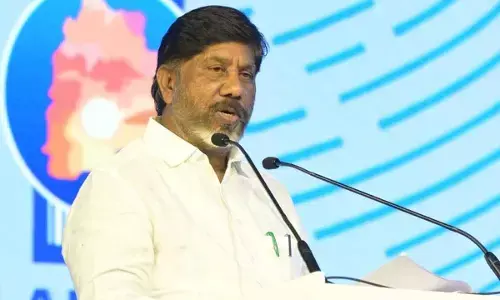Fueling India's Success: Trust, Tech, Talent, and Culture's Role in Growth

A strong workplace culture sustains industry growth by tech potential, attracting diverse talent, boosting engagement, fostering innovation, enhancing customer experiences, and contributing to the economy.
The CEO of Great Place To Work®India, Yeshasvini Ramaswamy, defines a great workplace as one where trust, pride, and camaraderie among employees prevail. India's tech advancements offer immense potential, with digital transformation spanning rural to urban areas. Businesses are tapping into India's diverse talent pool through remote work, collaborations with education, and fostering diversity and inclusion. Leadership development is crucial for business competence and growth, achieved through identifying potential leaders, targeted training, continuous learning, coaching, and networking.
Yeshasvini Ramaswamy is recognized as one of India’s leading serial entrepreneurs. She combines deep expertise in organisational behaviour, artificial intelligence, and investment management to bring analytical rigour to business transformation projects. She has led numerous projects for Fortune 100 companies. She represented India in the Fortune Most Powerful Women program and received the Times Power Women Award for Excellence in Entrepreneurship. She is also a Fellow of the Institute of Directors. She is actively involved in community work through fundraising and participating on global advisory boards of high-impact NGOs in rural entrepreneurship, education, and health.
Yeshasvini Ramaswamy, CEO, Great Place To Work® India
How do you define a "great place to work," and what are the key factors that contribute to it?
Our 30 years of continuous research establish a great workplace as one where employees trust their leaders, take pride in their work, and enjoy their colleagues. We prioritise employees in our model, powering our Trust Index Survey™ and Culture Management platforms. Business leaders, research institutions, and the public rely on the Great Place To Work® Trust Model as the ultimate workplace standard.
Our For All™ Methodology expands on this by ensuring a consistently positive experience for every employee, underpinning our evaluation for Best Workplaces™ Lists. Great workplaces For All unlock human potential via strong leadership, meaningful values, and universal trust, fostering innovation and financial growth. For Allsignifies inclusivity, connection, and collective contributions.
How do you see the market potential for technological advancements for businesses in India?
India's tech advancement offers vast potential. The digital revolution spans rural to urban, driving sector opportunities. Swift adoption streamlines operations boosts productivity, and expands market reach. McKinsey predicts a $1 trillion digital economy by 2025 via internet use, smartphones, and initiatives like DigitalIndia, bolstering GDP. AI, blockchain, and IoT reshape industries for revenue. Embracing these techs yields a competitive edge. Organizations must nurture agility, innovation, invest in infrastructure, upskill, and promote learning. This fuels growth, propelling India's economy.
Enabling a workplace culture, irrespective of the demographics, can open up optimistic dimensions of an efficient workplace. How do you think organisations ramp up their D&I initiatives?
Diversity and inclusion boost workforce potential. Core values and leadership prioritize a safe, empowering environment. Robust D&I programs, unbiased hiring, equitable opportunities, and workshops foster inclusivity. Metrics track progress and surveys identify improvements. By embracing diversity and inclusion, organizations can tap into the collective intelligence, creativity, and innovation of their workforce. This, in turn, leads to improved employee engagement, enhanced customer experiences, and, ultimately, better business outcomes.
India’s talent pool is diverse and intense. How industries in India are tapping into the talent umbrella for sustained development?
India's talent pool is undoubtedly diverse and intense, offering a vast array of skills and capabilities across various industries. As a serial entrepreneur, I have witnessed firsthand how organizations are tapping into this talent umbrella to sustain their development and drive success.
To harness the potential of India's talent pool, organizations are adopting several strategies:
a) Building strong employer brands: Organizations focus on creating a compelling employer brand that attracts top talent. They highlight their unique organizational culture, growth opportunities, and employee-centric policies to differentiate themselves in the competitive talent market.
b) Embracing remote work and the gig economy: The COVID-19 pandemic has accelerated the adoption of remote work and the gig economy. Organizations are leveraging technology to tap into talent beyond geographical boundaries, enabling them to access a wider pool of skilled professionals.
c) Collaborating with educational institutions: Many organizations are collaborating with universities and educational institutions to bridge the gap between academia and industry.
d) Investing in learning and development: To tap into the diverse talent pool, organizations invest in continuous learning and development programs. They provide opportunities for upskilling and reskilling, fostering a culture of learning within the organisation.
e) Embracing diversity and inclusion: Organizations recognize the value of diverse perspectives and experiences in driving innovation and growth. According to our report, Historically excluded groups (HEG) comprise nearly 10% of the total workforce, as highlighted in our findings. Encouraging hiring from HEG communities is key.
By tapping into India'stalent umbrella, industries can leverage the skills and capabilities of a diverse workforce to drive innovation, improve productivity, and sustain their development in an ever-evolving market.
What is the need for organizations to drive Leadership Development for strengthening business competency?
Prioritizing leadership development is vital for robust business competence and sustainable growth. Our 2023 report, "India’s Best Companies To Work For™, highlights ForAll Leadership resulting in 62% more employees finding meaning in their roles. Strong leadership sets a tone, inspires, and executes vision. Investing in development builds capable leaders adept at innovation and adapting to market changes.
Organizations can drive leadership development by:
a) Identifying high-potential employees: Organizations should proactively identify employees with high potential and provide them with opportunities for growth and development. This can be done through talent assessments, performance evaluations, and succession planning.
b) Providing targeted training and development programs: Organizations should design and deliver training programs that focus on developing leadership competencies such as strategic thinking, effective communication, decision-making, and emotional intelligence. These programs can be delivered through workshops, coaching, mentoring, and online platforms.
c) Creating a culture of continuous learning: Organizations should foster a culture where learning and development are encouraged and celebrated. Leaders should lead by example and prioritise their own growth, inspiring others to do the same.
d) Offering leadership coaching and mentoring: Organizations can provide leadership coaching and mentoring to emerging and existing leaders. This personalized support helps leaders enhance their self-awareness, build their leadership skills, and navigate complex situations effectively.
e) Encouraging networking and collaboration: Organizations should create platforms for leaders to network, collaborate, and learn from each other. This can be achieved through leadership forums, industry conferences, and internal communities of practice.
By driving leadership development, organizations can build a strong leadership bench, foster a culture of excellence, and ensure a sustainable future for their business.
How great workplace culture can sustain the growth momentum of industries and businesses contributing to the overall economy in India?
A strong workplace culture drives industry and business growth, which is vital for India's economy. As CEO of GreatPlace To Work India, I've seen its transformative impact on engagement, productivity, and innovation. It values and motivates employees, resulting in performance in finance, retention, and customer satisfaction.
Here are some key ways in which a great workplace culture sustains the growth momentum of industries and businesses in India:
a) Attracting and retaining top talent: A great workplace culture acts as a magnet for top talent. It helps organisations attract high-calibre employees who are seeking a positive work environment, opportunities for growth, and a sense of purpose.
b) Driving employee engagement and productivity: A positive workplace culture promotes employee engagement and productivity. When employees feel a sense of belonging, trust, and empowerment, they are more likely to go above and beyond in their roles.
c) Fostering innovation and creativity: A great workplace culture encourages innovation and creativity. When employees feel safe to express their ideas, take calculated risks, and collaborate with their peers, they are more likely to contribute innovative solutions and drive continuous improvement.
d) Enhancing customer experiences: A great workplace culture has a direct impact on customer experiences. Engaged and satisfied employees are more likely to deliver exceptional customer service, going the extra mile to meet customer needs and exceed expectations.
e) Contributing to the overall economy: When organisations across industries prioritize building great workplace cultures, it creates a positive ripple effect on the overall economy. Engaged and fulfilled employees contribute to a productive workforce, leading to increased economic output, job creation, and higher living standards.
In conclusion, great workplace culture is a strategic asset for industries and businesses in India. It drives sustainable growth, enhances employee well-being, and positively impacts the overall economy. By investing in creating and nurturing great workplaces, organizations can lay the foundation for long-term success.


















